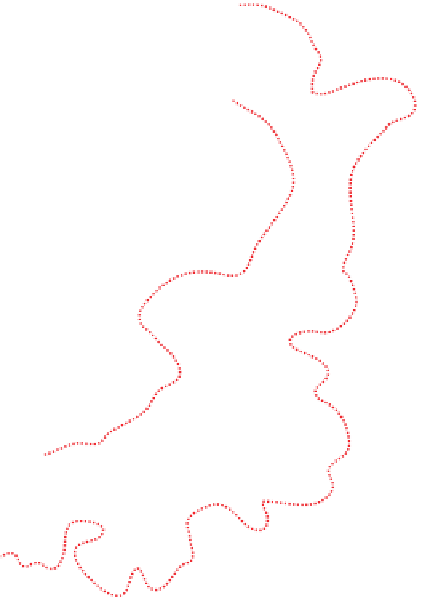Geoscience Reference
In-Depth Information
Pre-delta deposits
Mixed fluvial- and tide dominated delta
Tide-dominated delta
Distinct vegetation limit
Northern
distributary
area
N
10 Km
Samarinda
-0
°
30
ʹ
Area of possible past
connection of tidal
channels with the fluvial
system
Inter-
distributary
area
Area of smooth
transition from
delta platform
to delta front
Southern
distributary
area
-70m
-40m
-5 m
-10m
117
°
30
ʹ
Fig. 6.
Tide-dominated to fluvial-influenced autogenic process change, Mahakam Delta example. The northern and south-
ern distributaries are fluvial-dominated whereas the central (inter-distributary) area is tide-dominated (Storms
et al
., 2005).
Note that the platform in front of the delta is relatively even, suggesting that the tide-dominated central area also received
fluvial sediment in the past.
between long-lived distributaries in a tide-
dominated delta was observed in the Fly Delta
(Slingerland
et al
., 2008).
To summarise observations on the studied
Holocene deltas, the mapped process changes are
interpreted as autogenic responses that occur
down depositional dip or laterally, along deposi-
tional strike. The spatial and temporal changes are
intimately linked because the fluvial sediment
supply and the wave and the tide energy change at
a given location as the shoreline progrades. In the
examples presented, both spatial and temporal
autogenic changes occur but in some deltas only
one of the spatial or temporal process changes
dominates. The spatial autogenic process changes
dominate coeval Danube Delta lobes while the
spatial (lobe avulsion) and temporal (older lobes
gradually lost the fluvial input) process changes
are present in the case of the Mississippi Delta.
During the Mekong Delta progradation, the tem-
poral process changes explain delta variation
from tide-dominated to wave-dominated. In the
Mahakam Delta process changes between distinct
tide-dominated and fluvial-influenced lobes are
explained by spatial process changes generated by
the location of the fluvial distributaries.
It is not clear how much of the variability in
process regime is explained by spatial changes
(i.e. due to lateral switching of distributaries or
the lateral change of the wave regime because of
irregularities in the shoreline) and how much by
temporal changes (i.e. the process regime of the
overall delta system changes with time). The
understanding of the process changes, e.g. spatial
















































Search WWH ::

Custom Search